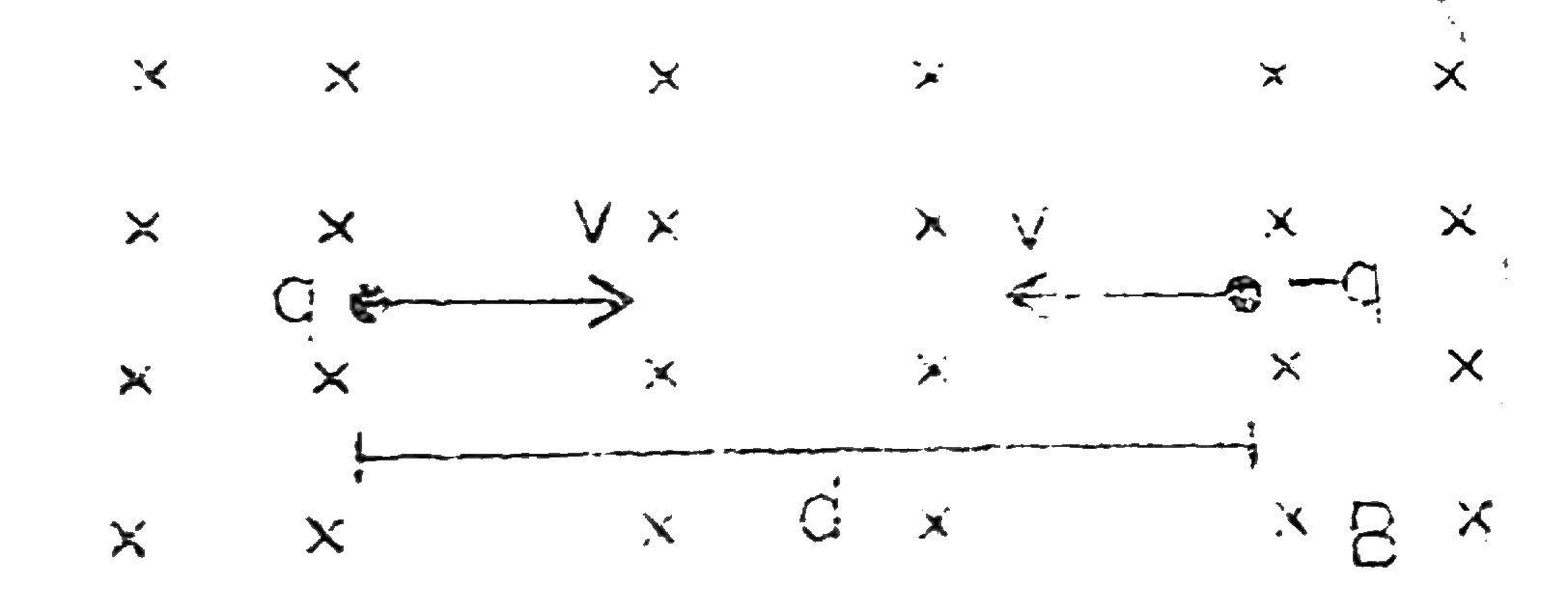Two identical particles having the same mass m and charges +q and - q separated by a distance d enter a uniform magnetic field as shown in the figure. For what value of d the particles will not collide?

Topper's Solved these Questions
- BOOK - AAKASH SERIESCHAPTER - ELECTROMAGNETICSEXERCISE - ADDITIONAL EXERCISE13videos
ELECTROMAGNETICS
- BOOK - AAKASH SERIESCHAPTER - ELECTROMAGNETICSEXERCISE - PROBLEMS (LEVEL -I)40videos
ELECTROMAGNETICS
- BOOK - AAKASH SERIESCHAPTER - ELECTROMAGNETIC WAVESEXERCISE - EXERCISE -II22videos
ELECTROMAGNETIC WAVES
- BOOK - AAKASH SERIESCHAPTER - ELECTROSTATICSEXERCISE - ADDITIONAL PRACTICE EXERCISE (PRACTICE SHEET (ADVANCED) INTEGER TYPE QUESTIONS)5videos
ELECTROSTATICS
Similar Questions
Two identical particles having the same mass m and charges +q and -q separated by a distance d enter a uniform magnetic field B directed perpendicular to paper inwards with speeds v1andv2 as shown in Fig. 1.139. The particles will not collide if
 View Solution
View SolutionWhen a charged particle enters a uniform magnetic field its kinetic energy
View SolutionA charge particle of mass m and charge q enters in a region of uniform magnetic field as shown in figure.The magnitude of change in linear momentum due to magnetic field will be
 View Solution
View SolutionTwo particle, each having a mass m are placed at a separation d in a uniform magnetic field B as shown in figure.They have opposite charges of equal magnitude q.At time t=0, the particles are projected towards each other, each with a speed v.
What would be the minimum separation between the particles if v=vm4?
 View Solution
View SolutionTwo particle, each having a mass m are placed at a separation d in a uniform magnetic field B as shown in figure.They have opposite charges of equal magnitude q.At time t=0, the particles are projected towards each other, each with a speed v.
What would be the maximum separation between the particles if v=vm4?
 View Solution
View SolutionTwo particle, each having a mass m are placed at a separation d in a uniform magnetic field B as shown in figure.They have opposite charges of equal magnitude q.At time t=0, the particles are projected towards each other, each with a speed v.
At what instant will a collision occur between the particles if v=2vm?
 View Solution
View SolutionTwo particle, each having a mass m are placed at a separation d in a uniform magnetic field B as shown in figure.They have opposite charges of equal magnitude q.At time t=0, the particles are projected towards each other, each with a speed v.
Suppose v=2vm and they stick to each other after the collision.Describe the motion after the collision (neglect the magnetic, gravitational & electric forces between charges).
 View Solution
View SolutionTwo particles, each having a mass m are placed at a separation d in a uniform magnetic field B as shown in they have opposite charges of equal magnitude q. at time t =0, the particles are projectd towards each other,each with a speed v. suppose the coulomb force between the charges is switched off. (a) Find the maximum value vm of the projection speed so that the two particles do not collide. (b) What would be the minimum and maximum separation between the particles if v=vm2? (c) At what instant will a collision occur between the particles if v=2vm ? (d) Suppose v=2vm and the collision between the particles is completely inelastic. Describe the motion after the collision.
 View Solution
View SolutionA particle with mass m and charge q moving with a velocity v, enters a region of uniform magnetic field B, shown, in the figure above. The particle strikes the wall at a distance d from the entance slit. If the paticle's velocity stays the same but its charge to mass ratio is doubled, distance frm the entrance slit where the particle strike the wall is dn, then find n
 View Solution
View SolutionA particle with mass m and charge q moving with a velocity v, enters a region of uniform magnetic field B, shown, in the figure above. The particle strikes the wall at a distance d from the entance slit. If the paticle's velocity stays the same but its charge to mass ratio is doubled, distance frm the entrance slit where the particle strike the wall is dn, then find n
 View Solution
View Solution
